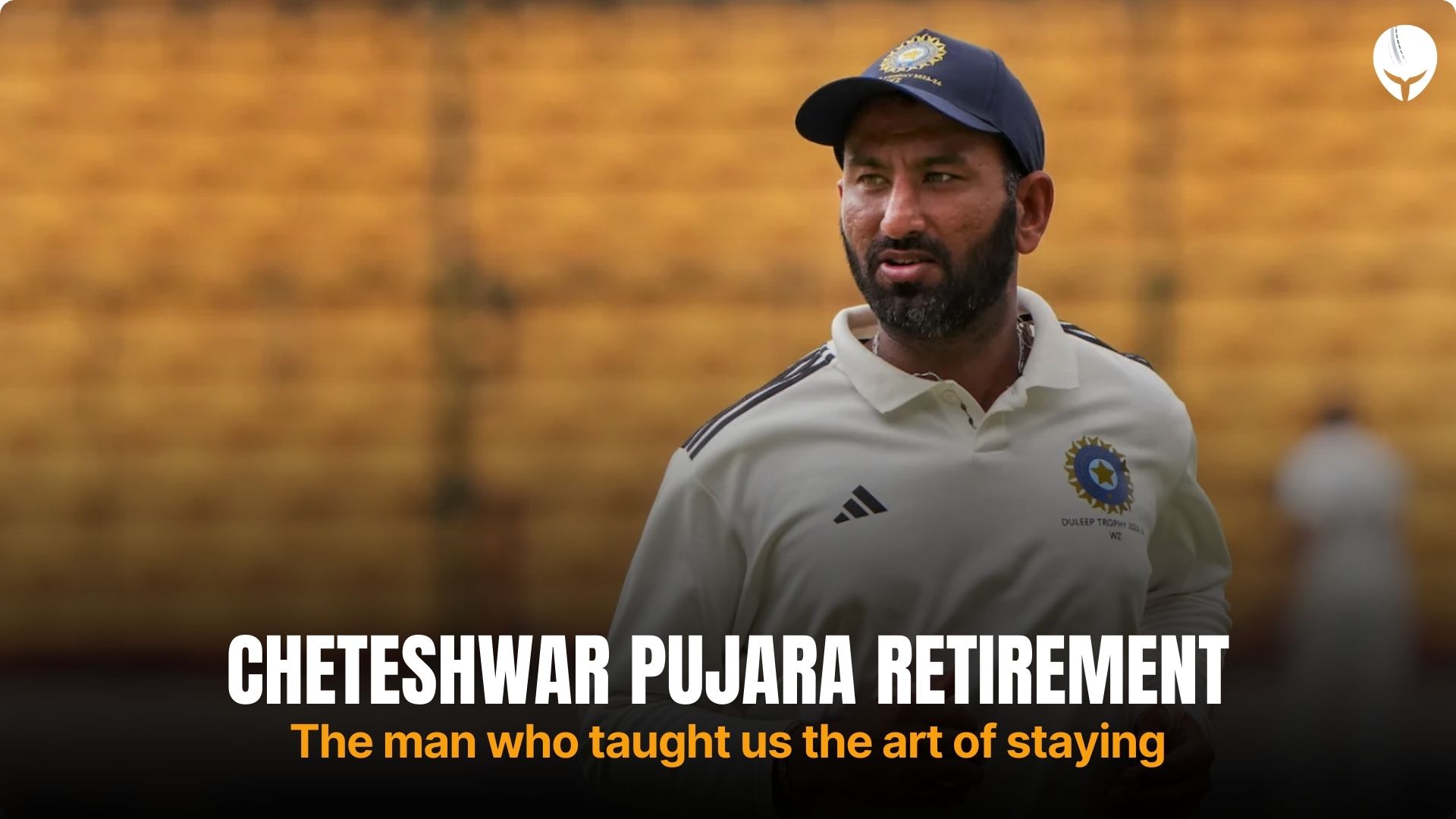With Cheteshwar Pujara announcing his retirement, the cricket world pauses to reflect on a career built not on flash, but on quiet determination.
I have seen many kinds of batters.
Some announce themselves with booming cover drives, some with audacious sixes.
But Cheteshwar Pujara?
He announced himself with silence.
No frills, no noise, no shortcuts. Just time. He was a man who could bat till the opposition broke.
The Wall After The Wall
If Rahul Dravid built the reputation of being “The Wall,” Pujara extended it. His bat was never about strike rates or trending reels. It was about grit. It was about patience. It was about the belief that if you stayed long enough, the game would come to you.
Runs That Didn’t Look Pretty, But Felt Priceless
Pujara earned every single run. Sweat, bruises, leaves outside off. His runs felt heavier because they carried the weight of effort.
When others chased highlights, he chased hours. That is why his big knocks felt bigger than a number on a board. They were lessons in how long-form cricket survives.
A Different Breed
In a cricket world moving fast, Pujara moved at his own pace. And maybe that is why he stood out. He taught us that batting is not always about flair, sometimes it is about fight.
Cricket Q&A
Five quick questions. Get a personal tip.
Cheteshwar Pujara retires as a reminder that in cricket, as in life, not everything is about speed. Sometimes, the greatest strength is the ability to stay.
What We Can Learn (and How to Train It)
1) Patience is power
Lesson: Time at the crease creates scoring chances. You don’t find momentum, you build it.
Drills:
- 20-minute Leave Challenge: In throwdowns, earn a point for every clean leave and every ball played late under your eyes. Deduct a point for a rash drive. Target +15.
- Dot-Ball Ladder: Bat in pairs. First over, allow only leaves and blocks. Second over, add singles. Third over, add one boundary option. Teaches build-up, not boom.
2) The leave is a shot
Lesson: Judgment wins as many runs as strokes.
Drills:
- Off-Stump Gate: Place a stump or cone on your off stump. Feeder works a fourth-fifth stump corridor. Call “leave” early and hold your shape. Ten perfect leaves before you’re allowed to drive.
- Traffic-Light Tosses: Coach calls “red” (leave), “amber” (defend), “green” (score). Random feed. Trains decision speed without panic.
3) Soft hands, late contact
Lesson: Edges die when your hands stay relaxed and you play late.
Drills:
- Under-Eye Contact: Throwdowns with a worn ball. Score only when the ball meets the bat below eye line. Anything in front of the pad line is a zero.
- Feather Defend: Aim to drop the ball within two pitch mats of your feet. Count how many in a row you “kill.”
4) Wear pressure so partners score
Lesson: Absorbing a spell can free the other end. That is contribution, not survival.
Drills:
- Shield and Score: Two batters. Shield faces first four balls of each over with a defend-or-leave rule. Scorer must rotate on balls five and six. Swap roles every two overs.
- Bowling Plan Swap: Bowlers set short bursts at one batter. Shield practices body-line awareness, leaving and soft blocks. Scorer works gaps and quick singles.
5) Routine over mood
Lesson: A repeatable routine beats nerves and dips in form.
Drills:
- Three-Step Ritual: Pick your three actions. For example, mark guard, look up, exhale. Do it for 36 balls non-stop. If you skip once, restart the count.
- Pressure Countdowns: Start on 10 runs needed, 12 balls left. Keep your routine every ball. Track how often routine slips under pressure.
6) Respect the grind
Lesson: Form is rented. Work pays the rent.
Drills:
- Season Log: Set a six-week target. Batters track “balls faced per session” and “leaves judged.” Bowlers track “maidens built” and “dot-balls in a row.” Record it on CricHeroes to keep yourself honest.
- Old-Ball School: Net with three balls of different ages. New, 30 overs, 60 overs. Adjust guard and scoring options as the ball ages. Learn conditions, not just shots.
For Captains and Organisers
- Role Clarity Board: Before games, write each batter’s role on the board. Anchor, accumulator, enforcer, finisher. Review after the match on role success, not only strike rate.
- Time-in-the-Middle Award: Celebrate minutes batted and balls faced, not just runs. Add a “maidens created” award for bowlers. It changes what your team values.
- Dot-Pressure Map: After matches, review dot-ball clusters and release shots over the same period. It shows how pressure built and where it broke.
For Keepers of the Game
If you run a league or academy, tell this story often. The one about a batter who made calm feel powerful. Give your players drills that honour patience, not only power. The highlight of the day can be a leave that set up a hundred somewhere down the line.
Thank you, Cheteshwar Pujara.
For teaching a generation that calm can roar, and resilience lasts longer than applause.
Disclaimer
This article is for informational purposes only. We are not affiliated with the BCCI or any cricket franchise mentioned here in. All team names, logos, trademarks, player images, and statistics are the exclusive property of their respective owners and used under fair use for illustrative purposes only. If you own rights to any content used here and wish it to be removed, please contact us promptly for immediate action. No copyright infringement is intended.

I am Manan Joshi , SEO All-Rounder at CricHeroes.
CricHeroes is the ultimate Cricket Scoring App and the world’s only true Cricket Network. With more than 4 crore+ registered cricketers using CricHeroes to Live Cricket Scores for their local cricket matches and tournaments, CricHeroes is already the #1 Cricket Scoring App Globally!
We also proudly present “CricHeroes Store” by CricHeroes, a dedicated shop for cricket apparel and accessories, helping players gear up for their game.















